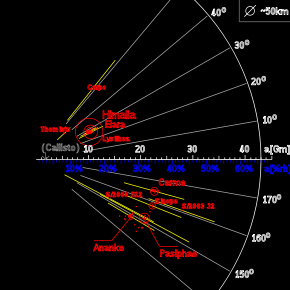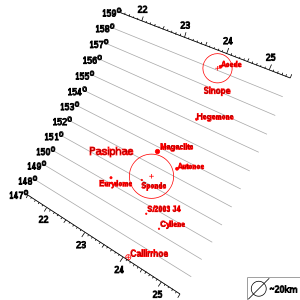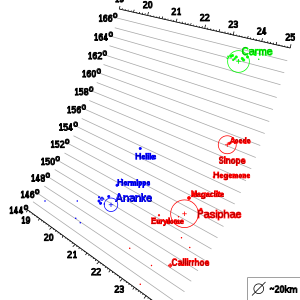
Pasiphaë group
Encyclopedia
The Pasiphaë group is a group of retrograde
irregular satellite
s of Jupiter
that follow similar orbit
s to Pasiphaë
and are thought to have a common origin.
Their semi-major axes
(distances from Jupiter) range between 22.8 and 24.1 million km (the same range as the Carme group
), their inclination
s between 144.5° and 158.3°, and their eccentricities between 0.25 and 0.43.
 Core members of the group include (from the largest to the smallest):
Core members of the group include (from the largest to the smallest):
The International Astronomical Union
(IAU) reserves names ending in -e for all retrograde moons, including this group's members.
which subsequently broke up after a collision. The original asteroid was not disturbed heavily: the original body is calculated to have been 60 km in diameter
, about the same size as Pasiphaë; Pasiphaë retains 99% of the original body's mass. However, if Sinope
belongs to the group, the ratio is much smaller, 87%.
Unlike the Carme
and Ananke group
s, the theory of a single impact origin for the Pasiphaë group is not accepted by all studies. This is because the Pasiphaë group, while similar in semi-major axis is more widely dispersed in inclination 1 . However, Secular resonance
s, known for both Pasiphae and Sinope, could shape the orbits and provide the explanation for the post-collision dispersal of the orbital elements. Alternatively, Sinope might be not a part of the remnants of the same collision and captured independently instead.
The differences of colour between the objects (grey for Pasiphaë, light red for Callirrhoe
and Megaclite
) also suggest that the group could have a more complex origin than a single collision.


1 Nesvorny 2003, concurring on Ananke and Carme groups, lists only Megaclithe for Pasiphae
Retrograde
-Retrograde:* Retrograde motion, in astronomy, describes retrograde motions of celestial bodies relative to a gravitationally central object* Apparent retrograde motion, in astronomy, is the apparent motion of planets as observed from a particular vantage point...
irregular satellite
Irregular satellite
In astronomy, an irregular moon is a natural satellite following a distant, inclined, and often eccentric and retrograde orbit. They are believed to have been captured by their parent planet, unlike regular satellites, which form in situ....
s of Jupiter
Jupiter
Jupiter is the fifth planet from the Sun and the largest planet within the Solar System. It is a gas giant with mass one-thousandth that of the Sun but is two and a half times the mass of all the other planets in our Solar System combined. Jupiter is classified as a gas giant along with Saturn,...
that follow similar orbit
Orbit
In physics, an orbit is the gravitationally curved path of an object around a point in space, for example the orbit of a planet around the center of a star system, such as the Solar System...
s to Pasiphaë
Pasiphaë (moon)
Pasiphaë is a retrograde irregular satellite of Jupiter. It was discovered in 1908 by Philibert Jacques Melotte and later named after the mythological Pasiphaë, wife of Minos and mother of the Minotaur from Greek legend....
and are thought to have a common origin.
Their semi-major axes
Semi-major axis
The major axis of an ellipse is its longest diameter, a line that runs through the centre and both foci, its ends being at the widest points of the shape...
(distances from Jupiter) range between 22.8 and 24.1 million km (the same range as the Carme group
Carme group
The Carme group is a group of retrograde irregular satellites of Jupiter that follow similar orbits to Carme and are thought to have a common origin....
), their inclination
Inclination
Inclination in general is the angle between a reference plane and another plane or axis of direction.-Orbits:The inclination is one of the six orbital parameters describing the shape and orientation of a celestial orbit...
s between 144.5° and 158.3°, and their eccentricities between 0.25 and 0.43.

- PasiphaePasiphaë (moon)Pasiphaë is a retrograde irregular satellite of Jupiter. It was discovered in 1908 by Philibert Jacques Melotte and later named after the mythological Pasiphaë, wife of Minos and mother of the Minotaur from Greek legend....
- SinopeSinope (moon)Sinope is a retrograde irregular satellite of Jupiter discovered by Seth Barnes Nicholson at Lick Observatory in 1914, and is named after Sinope of Greek mythology....
, two-thirds the size of Pasiphaë - CallirrhoeCallirrhoe (moon)Callirrhoe , also known as ' , is one of Jupiter's outermost named natural satellites. It is an irregular moon that orbits in a retrograde direction. Callirrhoe was imaged by Spacewatch at Kitt Peak National Observatory from October 6 through November 4, 1999, and originally designated as asteroid...
- MegacliteMegaclite (moon)Megaclite , also known as ', is a natural satellite of Jupiter. It was discovered by a team of astronomers from the University of Hawaii led by Scott S...
- AutonoeAutonoe (moon)Autonoe , also known as ', is a natural satellite of Jupiter. It was discovered by a team of astronomers from the University of Hawaii led by Scott S...
- EurydomeEurydome (moon)Eurydome , also known as ', is a natural satellite of Jupiter. It was discovered by a team of astronomers from the University of Hawaii led by Scott S...
- SpondeSponde (moon)Sponde , also known as ', is a natural satellite of Jupiter. It was discovered by a team of astronomers from the University of Hawaii led by Scott S...
The International Astronomical Union
International Astronomical Union
The International Astronomical Union IAU is a collection of professional astronomers, at the Ph.D. level and beyond, active in professional research and education in astronomy...
(IAU) reserves names ending in -e for all retrograde moons, including this group's members.
Origin
The Pasiphaë group is believed to have been formed when Jupiter captured an asteroidAsteroid
Asteroids are a class of small Solar System bodies in orbit around the Sun. They have also been called planetoids, especially the larger ones...
which subsequently broke up after a collision. The original asteroid was not disturbed heavily: the original body is calculated to have been 60 km in diameter
Diameter
In geometry, a diameter of a circle is any straight line segment that passes through the center of the circle and whose endpoints are on the circle. The diameters are the longest chords of the circle...
, about the same size as Pasiphaë; Pasiphaë retains 99% of the original body's mass. However, if Sinope
Sinope (moon)
Sinope is a retrograde irregular satellite of Jupiter discovered by Seth Barnes Nicholson at Lick Observatory in 1914, and is named after Sinope of Greek mythology....
belongs to the group, the ratio is much smaller, 87%.
Unlike the Carme
Carme group
The Carme group is a group of retrograde irregular satellites of Jupiter that follow similar orbits to Carme and are thought to have a common origin....
and Ananke group
Ananke group
The Ananke group is a group of retrograde irregular satellites of Jupiter that follow similar orbits to Ananke and are thought to have a common origin....
s, the theory of a single impact origin for the Pasiphaë group is not accepted by all studies. This is because the Pasiphaë group, while similar in semi-major axis is more widely dispersed in inclination 1 . However, Secular resonance
Secular resonance
A secular resonance is a type of orbital resonance.Secular resonances occur when the precession of two orbits is synchronised . A small body in secular resonance with a much larger one will precess at the same rate as the large body...
s, known for both Pasiphae and Sinope, could shape the orbits and provide the explanation for the post-collision dispersal of the orbital elements. Alternatively, Sinope might be not a part of the remnants of the same collision and captured independently instead.
The differences of colour between the objects (grey for Pasiphaë, light red for Callirrhoe
Callirrhoe (moon)
Callirrhoe , also known as ' , is one of Jupiter's outermost named natural satellites. It is an irregular moon that orbits in a retrograde direction. Callirrhoe was imaged by Spacewatch at Kitt Peak National Observatory from October 6 through November 4, 1999, and originally designated as asteroid...
and Megaclite
Megaclite (moon)
Megaclite , also known as ', is a natural satellite of Jupiter. It was discovered by a team of astronomers from the University of Hawaii led by Scott S...
) also suggest that the group could have a more complex origin than a single collision.


1 Nesvorny 2003, concurring on Ananke and Carme groups, lists only Megaclithe for Pasiphae

